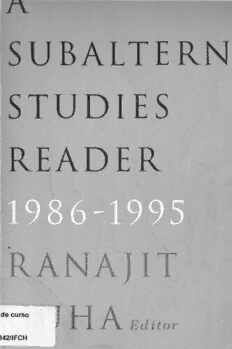
A Subaltern Studies Reader, 1986-1995 PDF
Preview A Subaltern Studies Reader, 1986-1995
SUB ALT E RN STUDIES READER ... RANAJIT A H · decurso Editor �42/IFCH Chapters 1 and 8 copyright 1992 by the Regents of the University of California. Reprinted from Representations 37 (winter 1992), pages 27-55 and 1-26, respectively. Chapter 7 first appeared in Partha Chatterjee, The Nation and Its Fragments: Colonial and Postcolonial Histories, copyright 1992 by Princeton University Press. Reprinted by permission of Princeton University Press. Poetry in chapter 1 reprinted by permission of Manazir Aashiq Harganvi. Copyright 1997 by the Regents of the University of Minnesota All rights reserved. No part of this publication may be reproduced, stored in a retrieval system, or transmitted, in any form or by any means, electronic, mechanical; photo copying, recording, or otherwise, without the prior written permission of the publisher. Published by the University of Minnesota Press 111 Third Avenue South, Suite 290, Minneapolis, MN 55401-2520 Second printing 1999 http://www.upress.umn.edu Printed in the United States of America on acid-free paper Library of Congress Cataloging-in-Publication Data A Subaltern studies reader, 1986-1995 I Ranajit Guha, editor. p. cm. Includes index. ISBN 0-8166-2758-4 (he: alk. paper). -ISBN 0-8166-2759-2 (pb: alk. paper) 1. India-History-British occupation, 1765-1947. 2. India-History- 1947- I. Guha, Ranajit. DS463.S77 1997 954.03-dc21 97-18632 The University of Minnesota is an equal-opportunity educator and employer. 10 09 08 07 06 05 04 03 02 01 00 99 10 9 8 7 6 5 4 3 2 Contents Acknowledgments vu Introduction 1x Ranajit Guha 1 I In Defense of the Fragment: Writing about Hindu-Muslim Riots in India Today 1 Gyanendra Pandey 2 I Chandra's Death 34 Ranajit Guha 3 I The Mentality of Subalternity: Kantanama or Rajdharma 63 Gautam Bhadra 4 I Origins and Transformations of the Devi 100 David Hardiman 5 I The Colonial Prison: Power, Knowledge, and Penology in Nineteenth-Century India 140 David Arnold 6 I Remembering Chauri Chaura: Notes from Historical Fieldwork 179 Shahid Amin 7 I The Nation and Its Women 240 Partha Chatterjee 8 I Postcoloniality and the Artifice of History: Who Speaks for "Indian" Pasts? 263 Dipesh Chakrabarty Contributors 295 Index 297 Acknowledgments The Editorial Collective of Subaltern Studies wishes to thank Shahid Amin, David Arnold, and Partha Chatterjee for their hard work in putting together the manuscript of this volume and Ranajit Guha for agreeing to write the introduction. It also wishes to thank the secretarial staff of the Centre for Studies in Social Sciences, Calcutta, for their as sistance in the preparation of the manuscript. The Editorial Collective is grateful to the following for their per mission to reprint these articles in A Subaltern Studies Reader: The Re gents of the University of California for Gyanendra Pandey's "In De fense of the Fragment," from Representations 3 7 (Winter I992): 27-55 ; Princeton University Press for the extract from Partha Chatterjee, The Nation and Its Fragments: Colonial and Postcolonial Histories (I992), pp. I I 6-34; and Oxford University Press, Delhi, for Ranajit Guha, "Chandra's Death," from Ranajit Guha, ed., Subaltern Studies V (I987): 135-65; for Gautam Bhadra, "The Mentality of Subalternity," from Ranajit Guha, ed., Subaltern Studies VI (I989): 54-9I; for the extract from David Hardiman, The Coming of the Devi: Adivasi Assertion in Western India (I987), pp. I-II, I8-54; for David Arnold, "The Colo nial Prison," from David Arnold and David Hardiman, eds., Subaltern Studies VIII (I994): I48-87; and for the extract from Shahid Amin, Event, Metaphor, Memory: Chauri Chaura, r922-r992 ( I995 ), II 5 -90. Vil Introduction Ranajit Guha The editors of Subaltern Studies have done me an honor by asking me to introduce this collection of essays. It is representative not only of the intellectual range spanned by the project but also of certain distinc tions the contributors maintain between themselves within an agreed orientation. This has indeed been a hallmark of Subaltern Studies from the very beginning-this insistence on a solidarity that would not re duce individual voices, styles, and approaches to a flat and undifferen tiated uniformity. It is a strategy that is not without its risks, of course. It has opened us to attack from those party-liners, one-horse riders, and other monists who had looked for the straight and the steady and the singular in our work only to find us wanting. But we have taken that risk in order to generate and continually renew a space that is vital to a project like ours. For its very existence, in concept as well as prac tice, depends on its ability to negotiate the tensions of an irreducible noncoincidence within it-a stubborn remainder that is an essential condition of its creativity and the source of its energies. It is perfectly consonant with such a strategy that the editorial col lective should call on me to add a few introductory words to the vol ume. For my place in this project is one that stands for a certain differ ence within its history. It is a difference of generations, which sets me apart from each of the other contributors by at least twenty-five years. Much of what gave Subaltern Studies its distinctive character and indi viduality during the first decade of its career-that is, roughly the pe riod covered by these essays-is owed to this hiatus, confirming some of Wilhelm Dilthey's insights into the phenomenon of generation.I In , , ,, \ °' IX
